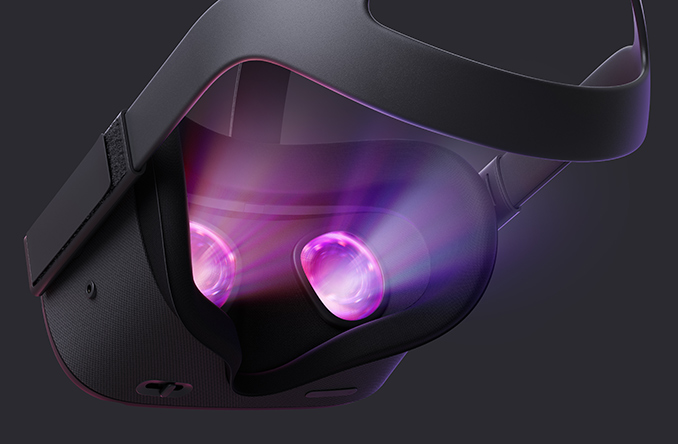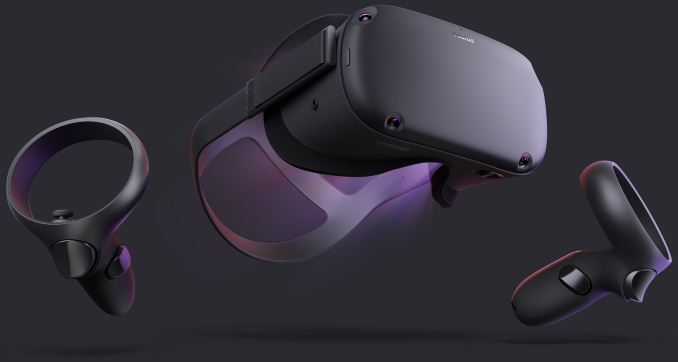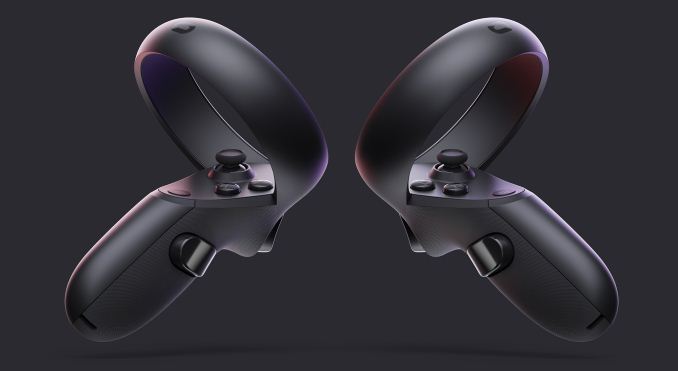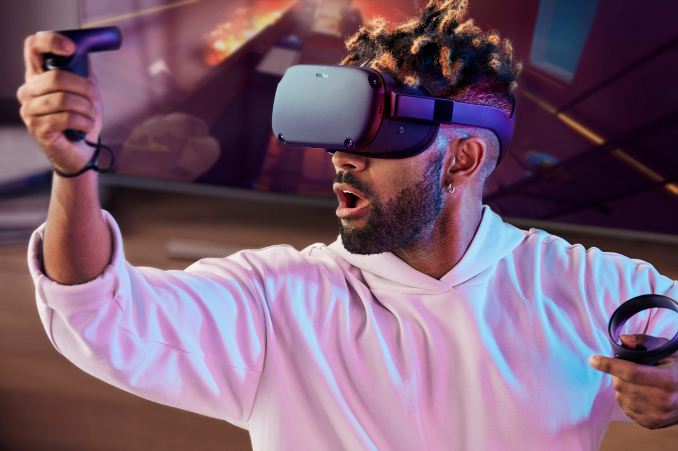Oculus Quest Announced: A 6DoF Standalone VR Headset
by Anton Shilov on September 27, 2018 5:00 PM EST- Posted in
- VR
- Oculus
- Oculus Quest

Oculus VR this week introduced its next all-in-one untethered VR headset, based around a 6-degree-of-freedom (6DoF) positional tracking system as well as the same optics as the Oculus Go launched earlier this year. Essentially an upscale, more powerful iteration of the Oculus Go, the new Oculus Quest will hit the market next spring at a price starting from $399.
The key feature of the Oculus Quest is its inside-out 6-degree-of-freedom (6DoF) positional and controller tracking that does not need any external sensors or a PC. The manufacturer says that tracking relies on four ultra-wide-angle sensors and computer vision algorithms, but does not go beyond that. When it comes to display subsystem of the Oculus Quest, the developer claims that the new unit has the same optics as the Oculus Go, but a display with a 3200×1440 (1600×1440 per eye) resolution (up from 2560×1440).
Besides graphics, Oculus VR also indicates improvements of built-in audio capabilities of the headset. Last but not least, the Oculus Quest will ship with its own Touch controllers that work just like controllers of the Oculus Rift, which will be a welcome upgrade when compared to the current-gen untethered Oculus Go headset that comes with a very simplistic controller.
Oculus VR has not disclosed which SoC it plans to use with the Quest, but considering the fact that the chip has to run games in a higher resolution than the Oculus Go and also process computer vision algorithms (unless Oculus VR uses a special purpose chip for them), it is safe to say that the new headset uses some kind of highi-end SoC (ed: it's since been confirmed that the SoC is a Snapdragon 835).
When it comes to games that take advantage of the Oculus Quest, the manufacturer promises that “over 50” titles will be available at launch, including games originally developed for Rift, such as Robo Recall, The Climb, and Moss.
The inclusion of Touch controllers as well as a more advanced SoC naturally had an effect on pricing of the new headset. The Oculus Quest 64 GB model will cost $399 (and this price alone implies on a more powerful SoC than the Qualcomm Snapdragon 821 used for the Go), which means that the unit will sit right above the Oculus Go ($199 - $249), but will still be more affordable than the Oculus Rift ($399) which requires a high-end gaming PC to function.
Related Reading:
- Oculus Go Now Available: Mainstream Standalone VR Headset Starts at $199
- HTC’s Standalone Vive Focus to Launch Worldwide This Year
- HTC Vive Pro HMD Pre-orders Start Today for $799; Vive Reduced to $499
- Lenovo Details Its Standalone Daydream VR HMD, The Mirage Solo at CES 2018
- HTC at CES 2018: Vive Pro VR Headset with Higher-Res Displays, Two Cams, Headphones
- VR Startup Varjo Announces Shipping of High Resolution Headset Prototype, Aimed at Professional Markets
Source: Oculus VR


















26 Comments
View All Comments
PeachNCream - Friday, September 28, 2018 - link
Isn't there a certain amount of compression to consider too. Like Steam wraps up a game in H.264 so it can push a relatively high quality video transmission over a rather slow link. Also, there's nothing stopping anyone from just running at 1800x720 to reduce bandwidth without dealing with interpolation losses when sending a video stream to a VR headset that has a panel resolution of 3600x1440. It wasn't that long ago that we were all terribly impressed at the image quality and realism of Freespace and it was locked at 640x480. Cutting the resolution would also open up a large number of more power efficient and cost effective graphics processors, even putting VR within the reach of some modern iGPUs. There's nothing better than getting your game on, but doing so without the 250W TDP graphics card to force you into a high cost, outdated form factor like a full ATX desktop.mode_13h - Wednesday, October 3, 2018 - link
Indeed HTC's wigig-based link *does* use compression.The idea of sending downsampled frames is pretty questionable. I think there's only so much blurriness that VR users would tolerate. If you wear corrective lenses, imagine walking around without them.
mode_13h - Wednesday, October 3, 2018 - link
I should add that it's probably not viable to use a common technology like H.264 compression, as that requires the entire frame as input, and will add non-trivial latency.The amount of compression that's achievable without unacceptable latency, power, or quality compromises is probably much less than what you can use for normal game or video streaming.
WorldWithoutMadness - Friday, September 28, 2018 - link
Latency, bandwidth, and power consumption. As you can notice, they don't even put battery life info. I'm guessing it's very limited. There'll be a lot of health problem due to weight if it has long battery life.Diji1 - Friday, September 28, 2018 - link
I imagine battery life is one to two hours with demanding applications based on current mobile devices.Hopefully they'll have hotswapping so you can charge and play at the same time, not that I intend on buying this device.
nevcairiel - Friday, September 28, 2018 - link
VR needs ultra-low latency, much more so then gaming on a big screen. Without quite specialized tech, both on software and hardware, this would definitely introduce a growing latency in comparison to cabled headsets.